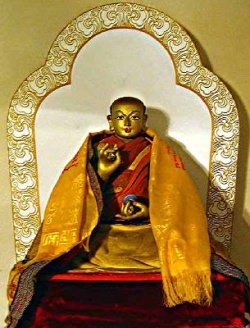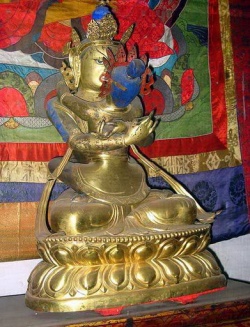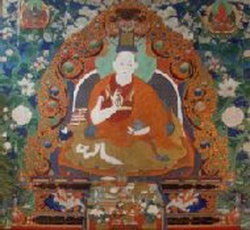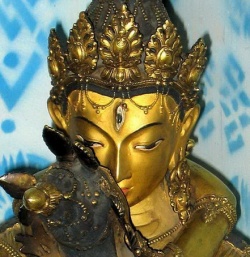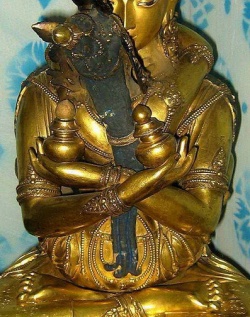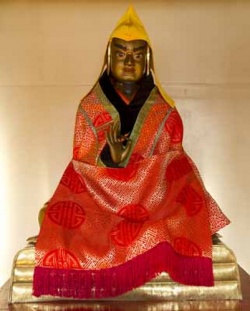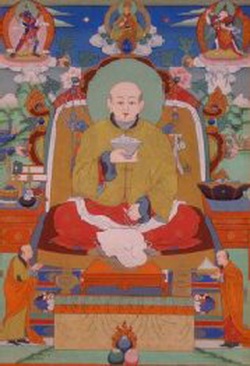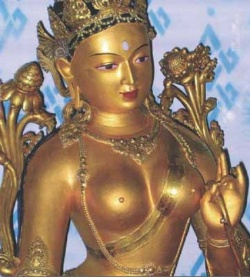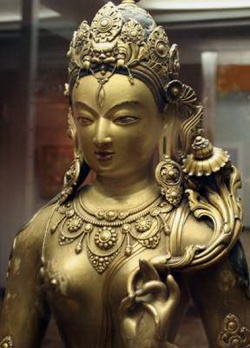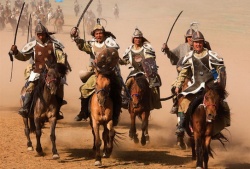Zanabazar Founds Gelugpa Monasteries in Mongolia 6
Zanabazar returned to Mongolia as a newly converted member of Gelugpa sect and armed with a brief to convert his fellow Mongolian to the same Yellow Hat beliefs. He forthwith announced that he would now longer live in any monastery connected with the Sakya sect which had hitherto been dominant in Mongolia. Thus his first course of action was to establish a new Gelugpa monastery near the confluence of the Tuul and Selbi rivers, in the large basin surrounded by the four mountains now called Chingeltei Uul, Bayanzurkh Uul, Songino Uul , and Bogd Khan Uul. Although it is not precisely clear from the record what the original name of this monastery was it soon became known as Örgöö, meaning "palace" or "camp" of an important person." Later this word would be corrupted into "Urga", which would become the name used by foreigners for the capital of Mongolia before it was changed in 1924 to Ulaan Baatar.
According to the Mongolian chronicle Erdeni-yin-erike the new monastery consisted of seven aimags, or divisions, each of which had it own assigned duties. The aimag known as Amduunar, made up of Tibetan lamas from the Amdo Region (roughly modern-day Qinghai province of China) who had come back from Tibet with the Bogd Gegen, was invested with task of instructing and educating lay people in Buddhism and specifically, we may assume, in the Gelugpa doctrines. Three aimags (Jisa, Sangai, and Dzoogai) were assigned to look over the personal needs of the Bodgo Gegen, prepare meals for the entire monastery, guard the monastery's supplies and treasury, and maintain order in the community. The remaining aimaks (Khüükhen noyan, Darkhan emchi, and Urliuud) were temples for worship maintained at the expense of followers of the Bogd Gegen. According to traditional accounts, upon his return to Mongolia Zanabazar also constructed two the temples of Vajradhara and Tabun-idzaagurtu; whether these were connected with Örgöö it is not quite clear."
Apart from establishing Gelugpa monasteries, little is known about Zanabazar's attempts to instill the Gelugpa doctrines in Mongolia. Pozdneev, surveying the traditional Mongolian accounts available in the 1890s, exclaimed,
"What is remarkable is the total absence of testimony concerning the manner in which the Gegen, having become a worshipper of the Dalai Lama and a follower of the Ge-lug-bas, forced out the rites and theories of the Sakya sect, which up to that time had been accepted in Khalkha. In all probability, the Ge-lug-ba lamas who accompanied the Gegen, seeing that the theoretical knowledge was but slightly developed in Khalkha, decided that the Khalkas might be converted without any struggle and that all that would be necessary would be to conduct the matter steadfastly and to introduce every innovation gradually, and then the people would not even notice the transition from one sect to another."
Thus is would appear-keeping in mind that most subsequent histories were written by Gelugpa monks-that Mongolia was spared the sectarian strife which had plagued Tibet in the 1630s and early 1640s and resulted in the forceful suppression of the Jonangpa sect to which Zanabazar's previous incarnation belonged.
Zanabazar apparently spent much of 1652 establishing his new monastery at the confluence of the Tuul and the Selbi. In early 1653, according to the Rosary of White Lotuses, but mentioned in no other biography of Zanabazar, he traveled south across the Gobi Desert to Inner Mongolia for yet another meeting with the 5th Dalai Lama, who at that time was just returning from a visit to the Qing emperor Shunzhi in Beijing.
The Ming Dynasty had been overthrown and the Qing Dynasty established eight years earlier in 1644. The nominal founder of the Qing Dynasty, Abahai, had died a year before and left the throne to his five year old son Shunzhi. Thus the emperor was only fourteen or fifteen years old when he met the Dalai Lama-a detail omitted by the Rosary of White Lotuses-and was no doubt heavily under the influence of his regents. Nevertheless, "His faith in the Gelugpa teaching and its holders was unshakable," according to the Rosary.
Shunzhi, or his Qing advisors, had sent a delegation to Lhasa to invite the Dalai Lama to Beijing back on 1650, but the Great Fifth was initially reluctant to go, fearing both the smallpox then raging in China and the political implications of appearing as a supplicant in the Qing court. After a period of meditation at the Oracle Lake he decided that the Qing Emperor could not be ignored and that he would have to make the lengthy journey to China.
The young emperor Shunzhi personally rode out outside of Beijing to met the Dalai Lama and escorted him into the capital, where the so-called the Golden Palace had been specially built at the cost of 90,000 silver sangs to house the Tibetan religious leader. Shunzhi showered the Dalai Lama with a vast array of gifts-golden tea-churners, thousands of rolls of brocade and silk, golden saddles, skins of tigers, leopards, and various other fauna, pearls, silver ingots, and much else-and gave him the honorific of "Precious Glory of the West, Sovereign of the World, Possessor of All Wisdom, All-Knowing One, Talai Lama Vajradhara." The Dalai Lama reciprocated by anointing Shunzhi the "Lordly Emperor Melodiously Wise Bodhisattva Sky Divinity".
Dalai Lama biographer Glenn Mullin, surveying the literature on the subject, provides an explanation for this love-fest:
Some modern historians suggest that the emperor's motives in inviting the Dalai Lama to Beijing and showing him such respect was to gain his peace-keeping influence with the tribal groups that lived along his western and northwestern borders. As the highest reincarnate lama in the Tibetan Buddhist world, the Great Fifth was held in great standing by the Tibetan and Mongolian tribes that lived in these regions. A good word from him would go a long way in mitigating conflicts.
The Dalai Lama left Beijing on the 20th day of the 2nd Hor month of 1653, according to the Rosary, having been given one final gift by the Emperor-a rosary made of pearls each the size of the tip of a thumb. After journeying ten days from Beijing, apparently in what is now Inner Mongolia, the Dalai Lama had the meeting with Zanabazar mentioned in the Rosary. Unfortunately more details are lacking. Ten days later, on the 10th of the third month, we are told that the Dalai Lama arrived at Taika Monastery (apparently in current-day Inner Mongolia; exact location unknown) where he met with a large assemblage of Mongols and Tibetans. Whether Zanabazar accompanied the Dalai Lama to Taika-assuming that he was in Inner Mongolia in the first place- and was present at this gathering is not clear. If he was he must have surely been impressed: "The faithful from all over Hor and Sog assembled there. . . To all of them, he [the Dalai Lama] gave a great and uninterrupted stream of the Dharma nectar. He was offered gold, silver, horses, cattle, etc., in amounts difficult for the mind to comprehend," the Rosary of White Lotuses tells us, adding somewhat enigmatically, "which was posing understandable problems every now and then." We do know that later in 1653 Zanabazar traveled to Erdene Zuu, founded by his great-grandfather, and appeared before a convocation of Khalkh nobility. It is not quite clear if Erdene Zuu was at that time still a Sakya stronghold-it had been consecrated by Sakya monks-or if Zanabazar actually stayed within the confines of the monastery. In any case, at this time he prevailed upon his followers to build him a new retreat in the mountains about 50 miles southwest of Erdene Zuu, at a place Shireet Ulaan Uul.
In 1648, about the time he had founded Baruun Monastery on the Shariyn Gol, between Erdene Zuu and Shireet Ulaan Uul, Zanabazar had noticed a flat-topped peak among the ridges west of the Orkhon River and apparently decided it was an auspicious spot. Upon his return from Tibet in 1561 he had a small stone-walled mediation hut built here. Then in 1653, while at Erdene Zuu, he asked that a temple and retreat be built here for his personal use. Later it also became a workshop where many of his most famous artworks were created. After his death it became known as Tövkhon Monastery, the name by which it is known today.
In 1654 we find Zanabazar in the Baga Khentii Mountains, part of the Khentii Range in what now T öv Aimag. Above the valley of a small tributary of the Tuul River known as the Khiidiyn Gol, about five miles southeast of 8717' Khiidiyn Sardag Uul, Zanabazar established yet another Gelugpa monastery. Its official name was Ribo-gejai-gandan-shadublin (The Rosary of White Lotus's Riwo-Gerjay Gandan Shendrup Ling), but like Zanabazar's residences at Shireet Tsagaan Nuur and at the monastery founded at the confluence of the Tuul and the Selbi three years earlier, it also became known as Örgöö. Thus it would seem that by this time the tradition had been established that wherever the Bogd Gegen was in residence was called Örgöö. Mongolian sources indicate that this monastery on the upper Tuul was also known as Ikh Khuree, the name by which the monastery on at the Shargiyn Gol-now known as Shankh-near Erdene Zuu was also originally called. Thus Örgöö and Ikh Khuree apparently became synonymous for the residence of the Bogd Gegen, wherever it may have been at the time. Not until much later, in 1779, was a permanent, official residence for the Bogd Gegen established near the confluence of the Tuul and the Selbi rivers, finally ending the peripatetic wanderings of Örgöö and Ikh Khuree. As noted earlier it was this Örgöö at the Tuul and the Selbi that would eventually become known by the name Urga to non-Mongolians.
Apparently Zanabazar planned to make the monastery on the upper Tuul-in what is now a very remote area sixty-three miles north of current-day Ulaan Baatar-the new center of Buddhism in Mongolia. On the lower slope of Bukh Yan Mountain, at an elevation of about 6000' a naturally occurring terrace was built up and enlarged into a flat area measuring some 650 by 575 feet. Here eventually were to be built seven large temples, three big stupas, and attendant buildings. Perhaps influenced by what he had seen in Tibet and by the Tibetan monks and artisans in his entourage, Zanabazar employed Tibetan designs in the construction of the temples. This was an extensive project and Zanabazar was only able to initiate it in 1654. An Amdo Aimag, presumably in large part made up of Tibetan lamas from Amdo who had accompanied Zanabazar back from Tibet, was eventually established, along with several other aimags and a Tantric College. The entire complex was not completed until 1680. The monastery did not survive long; as we shall see, it was completely destroyed in the internal upheavals of the late 1680s.
Having established at least three monasteries and well on his way to his goal of solidifying the position of the Gelugpa sect in Mongolia, in 1655 Zanabazar apparently decided to enlarge his sphere of influence even further by sending an embassy to the Qing emperor Shunzhi. Perhaps he had been influenced by the Dalai Lama's spectacular reception in Beijing and now thought that he himself should make the acquaintance of the Qing potentate. He therefore dispatched messengers to Beijing with gifts of various Buddhist paintings and statues. If he hoped for an invitation to Beijing he was disappointed.
"In return," Pozdneev, who was famously proficient in both Mongolian and Manchu written languages and thus presumably had access to the relevant source materials, tells us, Zanabazar "is honored with flattering eulogies; but there are absolutely no indications whatsoever to the effect that Shun Chih [Shunzhi] recognized in any way the Gegen's hegemony at the that time or had any intention of making him an instrument for influencing the Mongols."
As we shall see, a later Qing emperor would be all to ready to use Zanabazar as a means of influencing the Khalkha Mongols. Most traditional accounts do not mention Zanabazar’s trip to Inner Mongolia to met the Dalai Lama in early 1655. Skipping over this episode, they relate instead that in the summer of 1655 Zanabazar decided to make another trip to Tibet: “. . . I should like to accomplish my pious desire of again making obeisance to the Dalai Lama,” Zanabazar announced. “and especially to the Holy Panchen Vajradhara Lama [[[Panchen Lama]]] and hear the initiations and empowerments and so on which I meditated on before.” In preparation for the journey he decided to go into meditation for several months at his newly established retreat of Tövkhon at Shibeetu Uul. In the autumn of 1655 he left for Tibet.
The Rosary of White Lotuses claims that this trip to Lhasa was made “incognito” but offers few other details. If it was done incognito it is possible that Zanabazar announced that he was going in a very lengthy retreat and then after a few months in meditation in Mongolia quietly slipped off to Tibet with only a few escorts. We are offered no clues as to why Zanabazar chose to travel clandestinely. Indeed, at this point the traditional Mongolian accounts of Zanabazar’s life become untethered from reality and assume an altogether fabulous character.
“Then taking six men as escorts,” one account informs us, “he proceeded by forced stages continually on horseback and in seven days and nights arrived in the land of Tibet.“ The timeframe here is obviously erroneous. As noted earlier the fastest ever recorded trip from Urga to Lhasa was made in seventy-nine days by Avgan Dorzhiev in 1899-1900.
The speed of the journey was explained by the assertion that it was not accomplished by the traditional means of horse and camel. Instead, Zanabazar and his six traveling companions turned into turpans, the so-called “lama ducks” (galuu in Mongolian) common in Mongolia in summertime, and flew to Tibet. Any number of miraculous events occurred during this flight south to Lhasa. Some of the more picturesque is paraphrased by Pozdneev from traditional accounts:
A Mongol of Sain Noyan aimak who was keeping watch over his grazing sheep saw seven turpans flying through the skies toward the southwest. Knowing that these birds are found only in Khalkha during the summer, the Mongol decided that now, in late autumn, only Buddhas or Bodhisattvas could be flying in the form of these ducks. He immediately herded his sheep home and said to his wife, ‘A procession of Buddhas is coming, cook some meat right away and prepare a dombo of tea. I will go to entertain them.’ The Mongol woman cooked tea and food, and her husband, taking these refreshments with him, set forth toward the southwest, the direction toward which the birds had flown. It had already become dark when he saw that there were seven persons whom he did not know sitting on the open and level steppe. Coming up to them, he told them of his vision, what he had surmised, and of his decision to entertain the Buddhas, and then he concluded this tale by saying that insomuch as the number of wayfarers who were sitting here coincided with the number of flying birds, he would therefore make them a present of his refreshments. The wayfarers accepted the food which had been brought to them, and the Gegen (it was he and his lamas) gave the cordial Mongol a handful of flour as a return gift and said: ‘put this in your sacrificial cup used to summon happiness and thereafter you will be happy for all time.’ This prophecy was wholly fulfilled, and the descendants of this Sain Noyan man live as rich men to this very day.
Yet again:
On the way, of course, the Gegen was protected by the mighty choijons (protective genii), but, nevertheless, the trip was not managed without adventure. As they camped for the night at the Tarya-khulusun landmark, the wayfarers had all of their horses stolen. When they arose in the morning and the time for their departure was already approaching, they reported the loss to the Gegen. ‘I am protected by a large number of Choi-jins, but what was Jamsaran [one of his traveling companions] doing?!’ cried the vexed Gegen, and then he ordered his servants to go searching toward the east. At that same moment and, in fact, from the east a cloud of dust arose and began to approach nearer. These were the Gegen’s seven horses galloping, and there were two thieves bound by their hair to the horses’ tails. The Gegen praised Jamrasan for his punctual delivery of what was lost and continued farther on his way.
After a procession of such adventures Zanabazar and company arrived in Tibet. As on his first trip he supposedly went first to Tashilhunpo Monastery in Shigatse to see the Panchen Lama. Unfortunately, according to the traditional account, the Panchen Lama had died three days before Zanabazar’s arrival. “Oh how unhappy I am, cried out Zanabazar, “Knowing my teacher, Vajra-dhara, to be of great age, I purposely made great haste that I might bow to him and acquire the rest of the precepts which I was not able to get before from his spiritual treasure house.”
Again this is an erroneous version of the events. The First Panchen Lama, Lobsang Chökyi Gyaltsen, was quite alive and kicking in 1655-56 and did not actually die until 1662. It is not at all clear why the authors of the traditional Mongolian accounts chose to insert here a fictional version of Zanabazar’s meeting with the Panchen Lama. Perhaps they simply wanted to surround Zanabazar’s trip with as much of an aura of mystery and miracles as possible. If this is the case they did not disappoint. After Zanabazar set forth a mandala in front of the body of the deceased Panchen Lama the latter’s face became animated; when Zanabazar set forth a second and a third mandala the Panchen Lama began to speak: “I should not have returned,” announced the revived Lobsang Chökyi Gyaltsen, “but once it became known to me that thou didst come from a far land and art wasting away in such sorrow, I resolved to come back.” The Panchen Lama then delivered a sermon and instructed Zanabazar on the Yamantaka Tantra and numerous other subjects. The Rosary of White Lotuses, which judiciously omits the whole seven-days-to-Tibet avian journey and the miraculous revivification of the Panchen Lama, says only that Zanabazar requested teachings from both the “Royal Father and Son” (Panchen and Dalai lamas) and “offered great prayers for the long life of the All-knowing Panchen.”
According again to traditional sources, the Panchen Lama asked Zanabazar if many people on Mongolia had been reincarnationed in the higher spheres of the Buddhist universe. Zanabazar opined that not many were born into higher realms nor were many reborn into lower realms as animals, pretas, and so on; most were reborn as human beings. The Panchen Lama then told Zanabazar that he should teach the Khalkh Mongols to recite the prayer known as Burilbi Lhabum. Pozdneev, writing in the early 1890s, reported, “Modern lamas affirm on this subject that it was owing to just this prayer that Buddhism flowered in Khalkha to such an extant that the Khalkhas now received not only ordination as bodhisattvas in their lifetime, but also rebirth as real bodhisattvas on their death.” Unfortunately I have not been able to identify this prayer further, nor to determine if it is still on use today.
Taking his leave of the Panchen Lama Zanabazar proceeded to Lhasa for audiences with the Dalai Lama. Other than the fact that Zanabazar received unspecified teachings from the Dalai Lama the Rosary of White Lotuses adds nothing more about this, the second, or perhaps third, of Zanabazar’s visits with the Great Fifth. Other accounts say simply that Zanabazar received precepts and dedications from the Dalai Lama and that the latter gave Zanabazar permission to visit any monastery in Tibet. Apparently a whole host of legends, many of them no less miraculous than the Mongolian versions, eventually accrued among Tibetans about Zanabazar’s second sojourn in Tibet.
There is one event which supposedly took place in Lhasa while Zanabazar was there that is not mentioned in any other traditional accounts but is nevertheless become a part of the oral history of the Bogd Gegen which has survived down to the present day. This is his alleged meeting in the Tibetan capital with Galdan, the son of Baatar Khongtaiji, the chieftain of the Choros Oirat.
The people known as the Oirat, or Western Mongols, consisted of four main tribes, the Choros, Dörböt, Torgut, and Khoshot. As mentioned earlier, Boibeghus Baatar, head of the Khoshot, had converted to Buddhism in 1620 and other Oirat rulers soon followed. It was Boibeghus Baatar’s brother Gushri Khan who had defeated the King of Tsang and helped the 5th Dalai Lama assume both spiritual and temporal power in Tibet. Although the Khoshot retained great influence because of their role as “Protectors of Tibet“, in the political realm they were soon out shadowed by the Choros, who in the 1620 and early 1630s were led by the charismatic warlord Khara Khula. Based just west of the Altai in the upper Irtysh River-Lake Zaisan-Tarbagatai Mountains region, Khara Khula attempted to rally around him the Western Mongol tribes who had earlier followed the Oirat khan Esen (r.1439-1455) and like Esen entertained dreams of reuniting all the tradition Mongol peoples, including the Khalkh, or Eastern Mongols.
Following the death of Khara Khula in 1634 his son Baatar Khongtaiji organized what would become known as the Zungarian Khanate (The name derives from the Mongol zuungar, or “left hand“, or “eastern side”; although the Oirat dwelt in the west end of the Mongol lands, the Choros tribe was the easternmost tribe of the confederation and thus on the “left hand“ looking southward, as the Mongols always oriented themselves.) Setting out on an ambition campaign of nation-building activities, he established a permanent capital city called Kubakserai on the Imil River and encouraged trade, agriculture, and small-scale industries like metal-crafting. He defeated the Kazakh tribesmen to his west and instituted extensive diplomatic and trade relations with the Russians to his north in Siberia. He had every intention of building a permanent, lasting nation which would transcend the ephemeral groupings and temporary alliances typical of nomadic peoples.
In 1640 Baatar Khongtaiji convoked an assembly of most of the Mongol peoples of Asia and proposed a pan-Mongolian confederation which would form a united front against all external enemies such as the Chinese, Manchus, and Russians and settle all internal differences in a peaceful manner. The meeting was held in early August at a place called Ulaan Buraa, near the Tarbagatai Mountains on the border between what is now the Xinjiang province of China and Kyrgyzstan. Present were representatives of the various tribes of the Zungarian confederation, including Gushri Khan of the Khoshot Mongols, whose daughter Baatar Khongtaiji had married. From the eastern end of the Mongol world came the Tüsheet Khan Gombodorj—Zanabazar’s father—the Zasagt Khan Subadai, various princes of the house of Setsen Khan, and other Khalkh leaders. Zanabazar, who had been named the Bogd Gegen a year earlier, would have been almost five years old at the time. There is no indication that he himself attended the meeting. From the western reaches of the Mongol world came the Torgut from the steppes of the lower Volga River. The attendees, under the leadership of Baatar Khongtaiji, attempted to draft a code or treaty which would provide mutual protection to both the Zungarians and the Khalkh, guarantee the free movement of peoples between the various Mongol lands, and defend the smaller tribes against foreign aggression.
Buddhism, under the auspices of the Dalai Lama, was to be the unifying thread in this new coalition. That is why it was so important to put the Dalai Lama on the throne of Tibet with the Mongols nominally in charge. It was in this context that Baatar Khongtaiji had sponsored the earlier Mongol incursions into Tibet under the leadership of Gushri Khan. As we have seen, two years later in 1642, Gushri Khan finally deposed the last king of Tibet and installed the Dalai Lama as both the spiritual and secular leader of the country.
The 1640 convocation was perhaps the last viable attempt to create a Pan-Buddhist world stretching from the Siberian taiga in the north to the crest of the Himalayas in the south, and from the Khingan Mountain in the east to the Volga River in the west. It was also perhaps the last chance to unite the Mongols into one great nation. As it turned out, long-standing disagreements among the various Mongol factions prevented the coalescence of the proposed union. For starters, the Zungarians felt that they themselves, as a rising power in Central Asia and the sponsors of Buddhism under the Dalai Lama, should play the leading role in the coalition, while the Khalkh still claimed that as the legitimate Chingisids, the descendants of Chingis Khan, they were the rightful leaders of the Mongol world. As for religion, they had their own little five-year old boy, Zanabazar, who they hoped would become the leader of Buddhism in country of the Khalkh.
Galdan, one of Baatar Khongtaiji’s twelve sons, and the grandson of Gushri Khan on his mother’s side, was born in 1644 or 1645. By then it had become a custom among the Oirat nobility to send some of their sons to Tibet to study and perhaps became monks. Galdan, who his father had marked out for a religious vocation, was dispatched to Tibet when he was six or seven. As a contribution to the Dalai Lama, Galdan’s father had sent along a gift of 110,000 taels (one tael equals roughly one ounce) of silver and a hefty amount of gold which was intended to be used for gilding ganjirs, the stupa-shaped ornaments found on the roofs of temples. According to the Rosary of White Lotuses Galdan was soon recognized as an incarnate lama of Wensa Monastery, which it places about twenty miles east of Shigatse.
Galdan was accompanied by a Oirat named Namkhaijantsan, who was apparently nineteen at the time. Namkhaijantsan was ordained by the Dalai Lama himself and ended up staying in Tibet for 18 years. He eventually became better-known by his title Zaya Pandita. A formidable polymathic scholar, he became famous for inventing the so-called “Clear Script” (tod bichig), a modification on the Uighur script already in use by the Mongols. Over 2000 manuscripts on religious subjects written in Clear Script still exist in the libraries in Ulaan Baatar, including forty-seven by Zaya Pandita himself composed between 1652 and 1662. His most famous work is the four-volume Clear Mirror of Teachings. He is probably the best known of Oirat Buddhists scholars
Details of Galdan’s early life in Lhasa and his training in Buddhism are lacking. Given the uncertainty about Galdan’s birth date it is unclear if he would have been in the Tibetan capital when Zanabazar made his first trip there in 1650-51. He would have been eleven or twelve in 1655 when Zanabazar made is second trip to Lhasa. As noted, the Mongolian novices and monks who came to Lhasa tended to stay at Drepung, where a special college would eventually be set up for their studies. It would have only when natural that these two scions of the most prominent families in the Mongol world, whose fathers had in fact met at the 1640 congress held at Ulaan Burgaa, would come to know each other. Zanabazar, the Sixteenth Jebtsun Dampa and first Bogd Gegen of Mongolia, was already an acknowledged leader of Buddhism in Mongolia. Galdan was the son of perhaps the most powerful Mongol of the time and the only one who entertained visions of a Pan-Mongol world stretching from the Khingan Mountains of Manchuria to the Volga River in Europe. While Zanabazar would seem to have been the dominant figure in religion, Galdan, as his birthright, might well have thought himself as Zanabazar’s superior in the secular realm. Did some jealousy or animosity between the two seed itself at this time? Was personal animosity the root cause of the vicious war which eventually broke out between the eastern and western Mongols, in which Zanabazar and Galdan would play the leading roles, and which would result in the almost total destruction of the Zungarians and the subjugation of the Khalkh by the Qing Dynasty of China? We can only speculate, but as we will see many of Galdan’s later actions bore the mark of a personal vendetta against Zanabazar. In any case, none of the tradition histories nor the Rosary of White Lotuses mention a meeting between Zanabazar and Galdan in Lhasa, but many Mongolians to this day believe they did met, and that this encounter marked the beginning of the conflict between the two which was to have such tragic consequences for the people of Mongolia.
The repertoire of miracles apparently exhausted, the accounts offer no details of Zanabazar’s return to Mongolia other than the fact that he arrived back in late autumn of 1656. The trip had been a success, however, in large part due to the miraculous events which supposedly took place. These stories, Pozdneev tells us, “had in their time an enormous influence on the minds of the superstitious Mongols and thus we are inclined to trust the biography of the Ondür-gegen which states that the Khalkhas, on hearing about the circumstances of this trip made by their hutukhtu to Tibet, began to venerate the hutukhtu and pray to him far more than they had before.”
